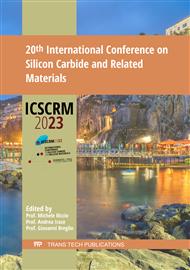[1]
J.H. Day, Thermochromism of inorganic compounds, Chemical Reviews 68 (6) (1968) 649-657 /
DOI: 10.1021/cr60256a001
Google Scholar
[2]
Y. Cui, Y. Ke, C. Liu, Z. Chen, N. Wang, L. Zhang, Y. Zhou, S. Wang, Y. Gao, Y. Long, Thermochromic VO2 for Energy-Efficient Smart Windows; Joule 2, (2018) 1707–1746 /
DOI: 10.1016/j.joule.2018.06.018
Google Scholar
[3]
H. Ramlow, K.L. Andrade, A.P.S. Immich, Smart textiles: an overview of recent progress on chromic textiles, J. Textile Institute 112(1) (2021) 152-171 /
DOI: 10.1080/00405000.2020.1785071
Google Scholar
[4]
R. Kulcar, M. Friskovec, N. Hauptman, A. Vesel, M. K. Gunde, Colorimetric properties of reversible thermochromic printing inks, Dyes & Pigments 86 (2010) 271-277 /
DOI: 10.1016/j.dyepig.2010.01.014
Google Scholar
[5]
X. Li, L. Xu, X. Li, M. Hu, R. Huang, C. Huang, Oxidant peroxo-synthesized monoclinic BiVO4: Insights into the crystal structure deformation and the thermochromic properties, J. Alloys & Compounds, 787 (2019,) 666-671 /.
DOI: 10.1016/j.jallcom.2019.02.136
Google Scholar
[6]
G. Ferro, D. Carole, F. Cauwet, L. Acher, H. Ji, R. Chiriac, F. Toche, A. Brioude, Thermochromic properties of some colored oxide materials, Optical Materials: X, 15 (2022) 100167 /.
DOI: 10.1016/j.omx.2022.100167
Google Scholar
[7]
X. Li, L. Xu, X. Li, M. Hu, R. Huang, C. Huang, Oxidant peroxo-synthesized monoclinic BiVO4: Insights into the crystal structuredeformation and the thermochromic properties, J. Alloys & Compounds787 (2019) 666-671 /.
DOI: 10.1016/j.jallcom.2019.02.136
Google Scholar
[8]
H.L. Tan, A. Suyanto, A.T. De Denko, W.H. Saputera, R. Amal, F.E. Osterloh, Y.H. Ng, Enhancing the Photoactivity of Faceted BiVO4 via Annealing in Oxygen-Deficient Condition, Part. Part. Syst. Charact. 34 (4)(2017) 1600290 /
DOI: 10.1002/ppsc.201600290
Google Scholar
[9]
W.J. Choyke, Optical properties of polytypes of SiC: interband absorption, and luminescence of nitrogen-exciton complexes,Proceedings of the International Conference on Silicon Carbide (1968), Mat. Res. Bull. Vol. 4, (1969) S141-S152 /
DOI: 10.1016/B978-0-08-006768-1.50018-8
Google Scholar
[10]
P.J. Wellmann, R. Weingärtner, Determination of doping levels and their distribution in SiC by optical techniques, Mater. Sci. and Eng. B102 (2003) 262-268 /
DOI: 10.1016/S0921-5107(02)00707-9
Google Scholar
[11]
W. Mokrzycki, M. Tatol, Color difference Delta E - A survey, Mach. Graph. & Vis. 20 (4) (2011) 383–411.
Google Scholar
[12]
D. Goto, Y. Hijikata, S. Yagi, and H. Yaguchi, Differences in SiC thermal oxidation process between crystalline surface orientations observed by in-situ spectroscopic ellipsometry,J. Appl. Phys. 117, (2015) 095306 /
DOI: 10.1063/1.4914050
Google Scholar



